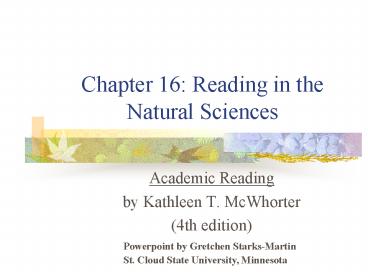Chapter 16: Reading in the Natural Sciences - PowerPoint PPT Presentation
1 / 14
Title:
Chapter 16: Reading in the Natural Sciences
Description:
Thought Patterns in the Natural Sciences. Process and Cause/Effect. 1. List the steps. ... the process aloud. Thought Patterns in the Natural Sciences ... – PowerPoint PPT presentation
Number of Views:23
Avg rating:3.0/5.0
Title: Chapter 16: Reading in the Natural Sciences
1
Chapter 16 Reading in the Natural Sciences
- Academic Reading
- by Kathleen T. McWhorter
- (4th edition)
Powerpoint by Gretchen Starks-Martin St. Cloud
State University, Minnesota
2
Learning Objectives
- To understand the scientific approach
- To develop specialized reading techniques for the
sciences - To learn to work with process, cause-and-effect,
classification, and problem/solution patterns - To adapt study strategies for the sciences
3
The sciences focus on asking questions about our
physical and biological world and seeking answers
to those questions.
4
Specialized Reading Techniques
- Preview Before Reading
- Adopt a Scientific Mind Set
- Learn Terminology and Notation
- Learn Symbols and Abbreviations
- Learn Everyday Words and Special Meanings
5
Specialized Reading Techniques
- Read Section by Section
- Study Sample Problems
- Study and Draw Diagrams
- Brush Up on Math Skills
6
Thought Patterns in the Natural Sciences
- Process
- Cause and Effect
- Classification
- Problem/Solution
7
Thought Patterns in the Natural Sciences
- Process and Cause/Effect
- 1. List the steps.
- 2. Draw diagrams or maps.
- 3. Describe the process aloud.
8
Thought Patterns in the Natural Sciences
- Classification
- Determine what is being classified.
- Look for a summary sentence.
- On what basis is the classification made?
- What characteristics do members of the group
share?
9
Thought Patterns in the Natural Sciences
- Problem/Solution
- 1. Read the problem and identify what is asked
for. - 2. Make a drawing of the problem.
- 3. State the principle of the problem.
- 4. Calculate the solution.
- 5. Analyze your answer.
- 6. Review your solution process.
10
Adapting Your Study Techniques
- Complete reading assignments before attending
lectures. - Highlight your textbook selectively.
- Use outlining.
- Integrate your lab work with
the text and lectures.
11
Adapting Your Study Techniques
- Use chapter problems as guides.
- Develop a weekly study plan.
- Prepare for exams.
- Make lists of problems.
- Identify key laws and concepts.
- Determine emphasis of instructor.
- Prepare a practice test.
- Join a study group.
12
If You Are Having Difficulty
- Use available resources.
- Make changes in your learning strategies.
- Learn from classmates.
- Double your study time.
- Purchase a review book or
use the CD-ROM with the book.
13
Summary Questions
- What are some specialized techniques for reading
the natural sciences? - What are the four thought patterns predominate in
the sciences? - What are some suggestions for adapting study
techniques in the sciences? - What can you do if you are having difficulty?
14
Read the biology article and complete the
exercises following the selection.
- Death Stars and Dinosaurs The Great Extinctions































